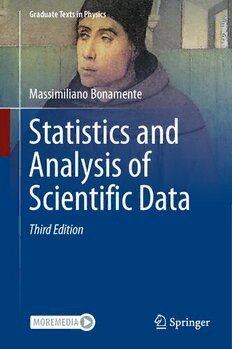Table Of ContentGraduate Texts in Physics
Massimiliano Bonamente
Statistics and
Analysis of
Scientific Data
Third Edition
Graduate Texts in Physics
SeriesEditors
KurtH.Becker,NYUPolytechnicSchoolofEngineering,Brooklyn,NY,USA
Jean-MarcDiMeglio,MatièreetSystèmesComplexes,BâtimentCondorcet,
UniversitéParisDiderot,Paris,France
SadriHassani,DepartmentofPhysics,IllinoisStateUniversity,Normal,IL,USA
MortenHjorth-Jensen,DepartmentofPhysics,Blindern,UniversityofOslo,Oslo,
Norway
BillMunro,NTTBasicResearchLaboratories,Atsugi,Japan
RichardNeeds,CavendishLaboratory,UniversityofCambridge,Cambridge,UK
WilliamT.Rhodes,DepartmentofComputerandElectricalEngineeringand
ComputerScience,FloridaAtlanticUniversity,BocaRaton,FL,USA
SusanScott,AustralianNationalUniversity,Acton,Australia
H.EugeneStanley,CenterforPolymerStudies,PhysicsDepartment,Boston
University,Boston,MA,USA
MartinStutzmann,WalterSchottkyInstitute,TechnicalUniversityofMunich,
Garching,Germany
AndreasWipf,InstituteofTheoreticalPhysics,Friedrich-Schiller-UniversityJena,
Jena,Germany
GraduateTextsinPhysicspublishescorelearning/teachingmaterialforgraduate-and
advanced-levelundergraduatecoursesontopicsofcurrentandemergingfieldswithin
physics, both pure and applied. These textbooks serve students at the MS- or
PhD-levelandtheirinstructorsascomprehensivesourcesofprinciples,definitions,
derivations,experimentsandapplications(asrelevant)fortheirmasteryandteaching,
respectively.Internationalinscopeandrelevance,thetextbookscorrespondtocourse
syllabisufficientlytoserveasrequiredreading.Theirdidacticstyle,comprehensive-
nessandcoverageoffundamentalmaterialalsomakethemsuitableasintroductions
orreferencesforscientistsentering,orrequiringtimelyknowledgeof,aresearchfield.
Moreinformationaboutthisseriesathttps://link.springer.com/bookseries/8431
Massimiliano Bonamente
Statistics and Analysis
of Scientific Data
Third Edition
MassimilianoBonamente
UniversityofAlabamainHuntsville
Huntsville,AL,USA
ISSN 1868-4513 ISSN 1868-4521 (electronic)
GraduateTextsinPhysics
ISBN 978-981-19-0364-9 ISBN 978-981-19-0365-6 (eBook)
https://doi.org/10.1007/978-981-19-0365-6
1st&2ndeditions:©SpringerScience+BusinessMediaNewYork2013,2017
3rdedition:©TheEditor(s)(ifapplicable)andTheAuthor(s),underexclusivelicensetoSpringer
NatureSingaporePteLtd.2022
Thisworkissubjecttocopyright.AllrightsaresolelyandexclusivelylicensedbythePublisher,whether
thewholeorpartofthematerialisconcerned,specificallytherightsoftranslation,reprinting,reuse
ofillustrations,recitation,broadcasting,reproductiononmicrofilmsorinanyotherphysicalway,and
transmissionorinformationstorageandretrieval,electronicadaptation,computersoftware,orbysimilar
ordissimilarmethodologynowknownorhereafterdeveloped.
Theuseofgeneraldescriptivenames,registerednames,trademarks,servicemarks,etc.inthispublication
doesnotimply,evenintheabsenceofaspecificstatement,thatsuchnamesareexemptfromtherelevant
protectivelawsandregulationsandthereforefreeforgeneraluse.
Thepublisher,theauthors,andtheeditorsaresafetoassumethattheadviceandinformationinthisbook
arebelievedtobetrueandaccurateatthedateofpublication.Neitherthepublishernortheauthorsor
theeditorsgiveawarranty,expressedorimplied,withrespecttothematerialcontainedhereinorforany
errorsoromissionsthatmayhavebeenmade.Thepublisherremainsneutralwithregardtojurisdictional
claimsinpublishedmapsandinstitutionalaffiliations.
PortraitofJohnDunsScotusbyJ.vanGhent,oilonpanel,circa1472–1476,GalleriaNazionaledelle
Marche
ThisSpringerimprintispublishedbytheregisteredcompanySpringerNatureSingaporePteLtd.
The registered company address is: 152 Beach Road, #21-01/04 Gateway East, Singapore 189721,
Singapore
Numbersdon’tlie
Foreword
ItisnowtheeraofBigData.Hugetrovesofquantitativeinformationresideevery-
whereandcanbeaccessedfromanywhereintheworldinaheartbeat.Whileourtools
for the collection and analysis of data have rocketed forward over a single human
lifetime, we remain human. As such, we can only hold a few simple numbers and
conceptsinourpoor,analogbrains.Werefertothoseconceptsasourunderstanding.
Statistical analysis of data allows us to make quantitative assessments of our
concepts,hopefullykeepingourpreconceptionsandmisconceptionsatbay.Butusing
statisticalmethodsisneverjust“turningacrank”.Wemustapplyjudgment.Wemust
becareful.Computerscaneasilylulloneintoafalsesenseofsecurity.Inhisthird
edition,ProfessorBonamenteprovidestheclearestexpositionofstatisticalanalysis
and the probability theory upon which it is based. He provides a roadmap to the
properuseofstatistics.
Intheopeningchapterofthisbook,theauthordiscussesBayesianversusFrequen-
tist statistical approaches. The Frequentist approach can be useful if one has no
underlying model for the mechanisms at play. But, in the Physical Sciences and
Engineering,sincethetimeofIsaacNewton,wehavemodelsthatrelyonparame-
ters.Andthoseparameters candistilltheunderstanding weseek.How tomeasure
thoseparametersandplaceerrorestimatesupontheresultsisthecentralthemeof
thisbook.
Today,therearesurprisinglyfewcoursesinstatisticsofferedatuniversities.And
thereareevenfewertextbooksavailabletosupportthoseclasses.Manyofthebooks
onstatisticsarewrittenforthebiologicalandmedicalfieldsandaresuitableforuse
inresearcharenaswheretheparametersandmechanismsarepoorlyunderstood.In
this text, you will find the approaches suitable for the analysis of data in physical
fieldsasopposedtothelifesciences.
Thisthirdeditionisthetextbookwehavebeenawaiting.Everyindividualwho
encountersdatainaprofessionalcapacityshouldreadit.Thematerialrangesfrom
thebasicsofprobabilitytotheseriousanalysisofdata.Anyindividualwhoworks
withdatadailyshouldmasterthematerialsinthisbook,keepingacopyforreference.
Ifrequentlyteachourdepartment’scourseindataanalysisandstatistics.Ihave
usedBonamente’ssecondeditiontogoodeffect,butthethirdeditionisthetextbook
vii
viii Foreword
Ihaveawaited.IonlywishIhadhaditbackwhenIwasastudent.Iamoldenough
thatIhadtouseaslideruleasanundergraduateanddidnotgainaccesstoahand
calculatoruntilgraduateschool.Computerswererunondecksofpunchcards.How
far our hardware tools have come! Yet the statistical tools employed today have
hardlychanged.
Even the data have changed. When I was young, astronomers employed film.
Today we use solid-state detectors that count individual photons at light levels so
lowthatmostofthedetectorbinshavecountednophotonsatall.Theswitchfrom
film(analog)tophoton-counting(digital)hascompletelychangedthenatureofthe
appropriatestatisticalanalysis.
In Chaps. 15 and 16, the author presents an approach to quantitative statistical
analysis of low-signal-count data. It is often the case today that many events are
recorded,buttheinstrumentstakingthedatahaveevenhigherresolution,i.e.,more
databinsthatevents.Inthesetwochapters,theauthordiscussestheapplicationof
PoissonStatisticstothislow-count-per-bindatausingtheCashStatistic.Henotonly
presentstheuseofthisCashStatisticbutdevelopsittoanewlevelthatshouldprove
usefulacrossarangeofmodernapplications.
Yes,theCashStatisticisnamedafterme,thewriterofthisforeword.Iwaslucky
enoughtoparticipateintheveryearlydaysofx-rayastronomyand,inparticular,be
involvedwiththeveryfirstx-raytelescopesbackinthe1970s.X-raysourceshave
notoriously weak photon fluxes, but every photon packs a punch, so it was x-ray
and gamma-ray astronomers who first had to reckon with the statistics of images
andspectrawhereasignificantfractionofthedatabinswereempty.Thedatawere
fundamentallyofaPoissondistributionnatureandcouldnotbeaddressedwiththe
usualassumptionofaGaussiandistribution.How,forexample,doesonedealwith
animagethathas1024binswithanaverageof.01x-raysperbin,yetthereisone
binwiththreex-raysinit,rightwherethetargetissupposedtobe?Theanswerlays
intheCashStatisticandshowingthatitwasdistributedasaChi-square.Professor
Bonamentehasnow,inthistext,broadenedthescopeoftheapplicationsandprovided
abetterframeworkfortheapplicationofthestatistic.
InPartIIIofthisbook,theauthoraddressesMonteCarlomethods.Theseareof
fundamentalimportancetomuchofmodernmodeling,particularlyinhighlycomplex
modelslikeraytracingofopticalsystems.Again,thisbooktakesthereader(student)
intorigorousanalysistechniquesthataredifficult,ifnotimpossible,tofindexplained
elsewhere.
Statistics can be a hard master. The math can be challenging. But in the age of
easy access to computing, the challenge to the user is to sift from all the numbers
the“understanding”thatissought.Themathbecomessecondary.Judgmentcomes
tothefore.WhatstatisticshouldIuse?Whatdotheresultsactuallymean?Itiseasy
tooverusethestatistics,findingstatisticallysignificantpatternsthatareactuallyof
nosignificance.
Foreword ix
And,astimegoesby,andone’sattentionmoveselsewhere,oneiscertaintoforget
howtoperformthestatisticalanalyses.Butthegeneralknowledgeoftherangeof
statisticaltoolswillstaywithyou.Then,whentheneedarises,pullthisbookoffthe
shelf.ProfessorBonamente’sbookwillbringitallback.
June2022 WebsterCash
ProfessorofAstrophysicalandPlanetarySciences
UniversityofColorado,Boulder
Preface
WiththethirdeditionofStatisticsandAnalysisofScientificData,Ihavecontinued
to pursue the goal of providing a textbook that is both mathematically sound and
easytouseforpracticalapplications.Dataanalysisstraddlestherigorousfieldsof
statisticsandmathematics,andthemessyworldofexperimentsanddatacollection,
inawaythatmakesitoftenunclearastowheretodrawthelinebetweenwhatneeds
tobedonetothedataandwhatshouldbedoneaccordingtotheavailabletheoretical
tools.Thistextbookaimstotreatboththetheoreticalandpracticalaspectsofseveral
keymethodsofdataanalysis,includingthelimitationsofcertaincommonpractices,
suchastheuseofthechi-squaredstatisticfornon-Gaussiandata.
Startingwiththesecondedition,Idecidedtomarkportionsofthetextbookthat
are primarily theoretical with a gray sidebar. These parts are not essential for the
practiceofdataanalysis,andtheycanbeskippedbythereaderwhoisnotinterested
in its theoretical underpinnings, or by the reader who needs a fast reference for a
methodthattheyalreadyknow.Ifindthatthisisaneffectivewayofpresentingcertain
mathematicallyintensivetopics,andIhavecontinuedwiththispracticeinthethird
edition.
Certainkeytheoreticalresultsthathaveagreatinfluenceonstatisticalmethods,
suchasH.Cramér’stheoremonthelimitingdistributionofthechi-squaredstatistic
orS.S.Wilk’stheoremonthedistributionofthelikelihoodratio,arenowpresented
inamoresystematicway.Themathematicaltheorybehindsomeoftheseresultsis
quite complex, and therefore I sometimes found it necessary to describe only the
main results, and then provide a reference to the original work, instead of delving
into too deep a mathematical treatment. The more theoretically inclined reader is
pointedtotherelevantreferencesinstead.Atthesametime,itisimportantthatthe
dataanalysispractitionerisawareofthesemathematicalresultsandthelimitations
they impose. A cautionary tale of what can go wrong when there is a mismatch
betweenthemethodofanalysisandtheunderlyingtheoryisinK.Pearson’suseof
the chi-squared statistic for contingency tables, which are now treated in detail in
Chap.10.Pearsonwaserroneouslyconvincedthat2×2contingencytableswithfixed
xi

